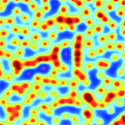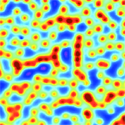Keep it local
The typical distance that an applied magnetic field penetrates a superconductor—called the penetration depth, —is an important measure that can be directly related to the superfluid density. Absolute values of are notoriously difficult to ascertain. Most experiments therefore measure the difference, = , which has the same temperature dependence as the superfluid density at low temperatures. A power-law dependence in suggests there are nodes in the superconductivity gap, while an exponential dependence implies a fully open gap.
Recent measurements of in iron pnictide superconductors of the - family show conflicting behavior: when the superconductor is doped with cobalt, there is a power-law dependence, suggesting nodes in the gap, but when doped with potassium, different experiments do not agree on the absence or presence of nodes in the gap. It turns out that to resolve this conflict, it may be necessary to measure the absolute value of .
In a Rapid Communication appearing in Physical Review B, Lan Luan and collaborators from Stanford University in the US have found a new way of measuring both the absolute value of the penetration depth and its spatial homogeneity using magnetic force microscopy (MFM) and SQUID susceptometry. Lan Luan et al. observe that for the - compound doped with cobalt, the superfluid density has a temperature dependence that is consistent with a fully gapped two-band model, similar to the potassium-doped material. Further, is found to be spatially homogeneous at the submicron scale, and absolute values of suggest that phase fluctuations are not as important for iron pnictides as for the underdoped cuprates. The ability of the new tool to obtain the absolute values of the penetration depth and to map its spatial variation down to the submicron scale is likely to be extremely useful. – Sarma Kancharla





